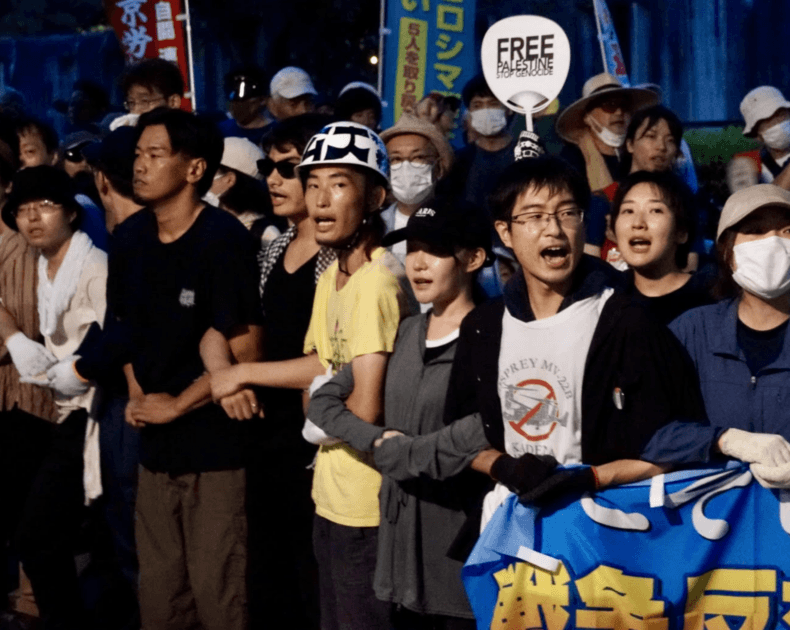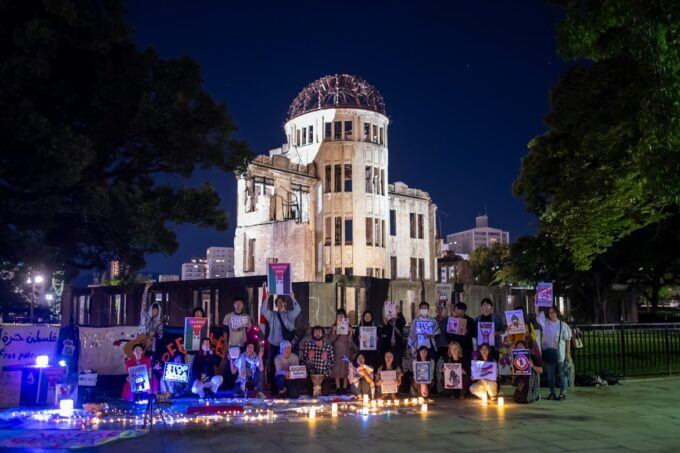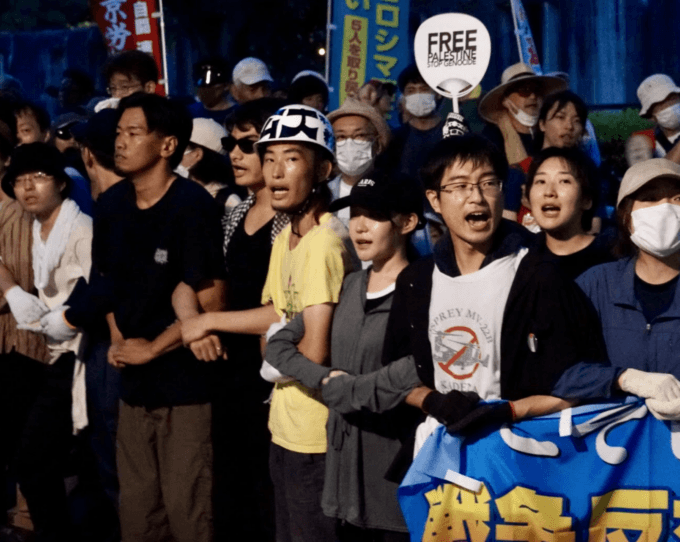

Hiroshima Palestine Community Vigil marking one year of a nightly standing in front of the atomic bomb dome in solidarity with the people of Palestine.
Hearing the announcement that Nihon Hidankyou had won the Nobel Peace Prize, Toshiyuki Mimaki-san pinched himself and said: “I thought it would have gone to the people working hard for Peace in Gaza.” Two days later, we witnessed the image of Sha’ban al-Dalou, a 20-year-old engineering student, burning alive in his tent outside the Al-Aqsa hospital in Northern Gaza, an IV still in his arm. These days, as we protest the genocide of the Palestinian people in front of the Atomic Bomb Dome here in Hiroshima, it is impossible not to recall the radioactive fires and mass death as part of a long lineage of American weapons experiments that continue to this very moment in Palestine.
“When I saw children being carried with blood covering them in Gaza, I remembered the scenes that took place in Japan 80 years ago,” Mimaki-san shared with the press in Oslo, recalling his experience as a 3-year-old exposed to the Hiroshima bomb. But his statements on Gaza were eliminated from most mainstream media. How deplorable – yet unsurprising – that the words of a survivor of nuclear genocide expressing empathy with other child victims of war be manipulated to obscure the current genocide.
Hibakusha commitment to No More Hiroshimas! No More Nagasakis! should guide us to solidarity with the Palestinian people, not distract us from it. From Hiroshima, Palestine solidarity activists urgently repeat: Palestine is a nuclear issue. Free Palestine must include a Nuclear-Free Palestine and resistance to the normalization of militarization, proliferation of nuclear weapons, AND power – that exists to create nuclear weapons. Anti-nuclear activists worldwide should be sounding the alarm about Palestine and taking concrete action to stop all weapons and escalation to nuclear war.
The Nobel Peace Prize has long been “tarnished” and used to peacewash nuclear deterrence. In 2009, Obama was awarded the prize for his supposed commitment to nuclear nonproliferation, then actually spent close to $1 trillion on upgrading the U.S. nuclear arsenal. Both Biden and Obama celebrated the win, while the Israeli ambassador to Japan, Gilad Cohen, criticized Mimaki-san for his comparison of Gaza to Hiroshima. Can we imagine if UNRWA – the UN agency whose schools, hospitals, and aid workers have been utterly destroyed and massacred while trying to do their jobs – had won this year’s Peace Prize?
In the years following the bomb, the American occupation censored anyone writing, speaking, or making art about their experiences of instant obliteration and radiation sickness. Not only were survivors of Hiroshima and Nagasaki shunned and shamed by their own communities, they were subjected to invasive medical testing by the U.S. Atomic Bomb Casualty Commission for most of their lives. Nevertheless, they have worked tirelessly to abolish nuclear weapons by recording and repeating their personal testimonies. Most hibakusha who were children at the time are now in their 80s and 90s and continue to share their legacy to the next generation of anti-nuclear activists.
Hiroshima, the “International Peace City” has a complex history of both being a victim and perpetrator of war. As a historic military outpost and center of the Japanese Navy, the symbol of the Atomic Bomb dome and the victimhood narrative of Hiroshima exemplify for the right-wing nationalists the root of Japan’s weakness and threat to its national security. This perceived need for “security” has justified the rapid militarization of Japan and bulwarking against China by building up missile bases in Okinawa, buying drones from Israel, manufacturing robots for Israeli weapons’ firms, or loosening regulations around defense equipment transfers.
This same victimhood narrative obscures the atrocities of imperial Japan in China, Korea, the Philippines, Indonesia, Southeast Asia, and the Pacific — the extensive networks of sex slavery, chemical weapons experiments, genocidal extermination, and colonial territorial expansion. An estimated 40,000 Koreans were killed in the bombs and thousands more exposed to radiation after being mobilized to Hiroshima and Nagasaki as forced labor. In response to the peace prize, Korean A-bomb survivor group president, Kim Jin-Ho, says that both the U.S. and Japan should apologize to the Korean hibakusha community: “Japan, being both an aggressor in war and a victim of the atomic bomb, needs to join the Treaty on the Prohibition of Nuclear Weapons and guide us toward a world without nuclear weapons.”

Chukakuha and student activists at all-night sit in in the early morning hours of August 6th protesting the Israeli delegate attendance to Hiroshima’s Peace Memorial Ceremony, Japan’s rapid militarization, and the protest restrictions imposed by the City.
As leaders of the anti-nuclear movement, hibakusha must refuse this ongoing Japanese nationalist victimhood narrative that exceptionalizes their experience and continue to utilize their position as peacemakers to advocate for all victims of the nuclear fuel cycle — from Shinkolobwe uranium mine in the Congo to the Sahtu Dene people in Canada who transported the uranium for the Hiroshima bomb, to the marginalized victims of nuclear testing in Bikini Atoll, Micronesia, Kazakhstan, the Aboriginal peoples of Australia, the Navajo Nation, the Nevada Test Site downwinders, Algeria, and more. By relating these global histories of nuclear colonialism, we can better understand how the anti-nuclear movement intersects with anti-colonial, anti-imperial struggles like the Palestine Solidarity movement, which is also an anti-war and anti-weapons testing movement.
In 2023, the G7 Summit was held in Hiroshima, where Kishida and the other nuclear states released their paradoxical “Hiroshima Vision” statement, committing to nuclear disarmament through the proliferation of nuclear weapons. Many hibakusha expressed shock and disappointment that the states who refuse to sign the TPNW could proclaim their continued commitments to nuclear weapons as a method of “safety” from the hypocenter of the nuclear bomb: “Nuclear weapons, for as long as they exist, should serve defensive purposes, deter aggression and prevent war and coercion.” One could argue that the city itself has become a peacewashing pawn of the Japanese national government under the thumb and “nuclear umbrella” of U.S. influence.
The city’s government has become increasingly conservative, removing the classic anti-nuclear manga, Barefoot Gen, from grade school peace education materials and utilizing parts of the Imperial Rescript on Education, part of the Japanese imperial militarist training, as part of training text for new city employees. The February arrest of five anti-war activists on false charges of attacking a Hiroshima City worker during last year’s August 6th anti-war protests was used to justify the banning of protests during this year’s Peace Memorial Ceremony. Under the guise of maintaining “silence” and “safety”, the city repressed public dissent while still inviting Israel – effectively peacewashing their own complicity in the genocide.
As activists pressured the city to disinvite Israel, Mimaki-san’s hidankyou was the only one of seven local hibakusha groups that sent a letter to the Mayor requesting a cancellation of Israel’s invitation. In the end, both Rahm Emanuel, the U.S. Ambassador to Japan, and an Israeli delegate attended the ceremony, laying flowers for atomic bomb victims as death toll in Gaza soared to 40,000. Activists staged actions throughout the park that day, including an all-night sit-in to protest the restrictions on free speech, which successfully defeated the regulations on no speakers or protest material during the ceremony. Zengakuren students, union workers, and older activists from across Japan sat through the night and the early morning ceremony, waving Palestinian flags and demanding an end to Japanese militarization.
Other groups of anti-war activists and Buddhist monks staged a die-in during the ceremony while activists from all around Japan waved signs at the entrances to the park. Inside the ceremony itself, protestors held their keffiyehs high over their heads during the 8:15am moment of silence for the victims of the bomb. On the evening of the 6th, as colorful floating lanterns drifted down the river to commemorate Hiroshima’s ancestors, Waleed Siam, a Palestinian Ambassador to Japan, gave a virtual address at a People’s Peace Ceremony. His image was projected to a crowd in front of the Atomic Bomb Dome, a massive fiery explosion in Gaza as his Zoom background, calling for justice and “for the world to uphold the principles it so often preaches but rarely practices.”
The saving grace of anti-nuclear movement solidarity with Palestine came from Nagasaki, where the Mayor disinvited Israel from their August 9th Peace Ceremony and instead invited a delegate from Palestine. In the aftermath of this invitation, Emanuel and the rest of the G7 ambassadors refused to attend the ceremony, shocking the Nagasaki community, including hibakusha. Local activists with Nagasaki for Palestine held their own event, welcoming the Palestine delegate with peace music sung by a hibakusha choir.
The mental gymnastics that we have had to do to understand the logic behind each of these scenarios – the manipulation of “peace culture” to justify war; the use of genocide testimonies to hide genocides; the respectability politics of “silence” to censor and control dissent – is mindboggling. “Peace” and its longtime advocates like the hibakusha continue to be manipulated by the press, and local and world governments to disguise their lucrative forever wars and performances of diplomacy.
With the doomsday clock set at just 90 seconds to midnight, the message of No Nukes! is prescient. By erasing Palestine from the lips of the few remaining hibakusha, the newsmedia continue their complicity in abetting this genocide. As we sink deeper into the horrors of Gaza and the blood continues to spill throughout the region, the voices of the hibakusha remind us of our responsibility to human life — and again and again their voices get co-opted to justify war. But we have heard their stories and we know the messages. How much further will we let ourselves be pulled into the abyss of genocide denial and human indignity?
In the words of hibakusha poet, Tōge Sankichi:
にんげんをかえせ
Ningen o kaisei
Give me back humanity
No Nukes! No War! Free Palestine!
The post How the Nobel Peace Prize Just Peacewashed the Genocide in Gaza appeared first on CounterPunch.org.
This post was originally published on CounterPunch.org.